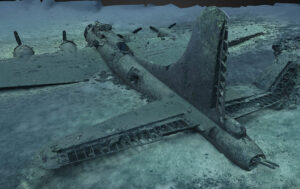The tech uncovering wrecks
Eighty-years after an American B-17 aircraft crashed into the sea off the Papua New Guinea coast during WWII, Black Jack has ‘re-emerged’ thanks to stunning 3D imagery that captured the Bomber on the sea floor. Associate Professor ANDREW WOODS says this work is just the start of where this digital survey mapping can lead.
Related Article
Wreckage of WWII bomber off PNG coast revealed in 3D on anniversary
On the 80th anniversary of the loss of an American B-17 Bomber that crashed into the sea off the coast of Papua New Guinea, Curtin University has released a complete and detailed digital 3D model of the wreck.
On July 11, 1943, WWII bomber ‘Black Jack’ crash landed into the sea near Boga Boga, about 300km east of Port Moresby. The aircraft was on a bombing mission to Rabaul from Port Moresby, but on the return journey bad weather and engine failure forced the aircraft to crash land, with all ten crew surviving the wreck.
The wreck site is difficult to access and even a diver can often only see a portion of the wreck at one time, however the 3D model allows the aircraft wreck to be viewed by anyone as one whole 3D object.
Australian recreational divers Grant Thomas and Andrew Hamilton captured detailed photography of the wreck, which Curtin HIVE research assistant Daniel Adams applied advanced image processing methods to in order to create the 3D model.
Associate Professor Andrew Woods, Manager of the Curtin HIVE (Hub for Immersive Visualisation and eResearch), said the model showed the wreck in amazing detail including bent propeller blades, damage at the front and back of the aircraft and even coconuts that had accumulated beside the wreck.
“Lying at a depth of 50m, the wreck is 23m long with a wingspan of 32m and despite the force of the crash and exposure to the underwater elements for decades, it remains largely complete,” Associate Professor Woods said.
“Making the model of the wreck available helps build knowledge and understanding of the significance and importance of underwater cultural heritage around Papua New Guinea.

“World War II was a dark time for PNG and the world. This stark and haunting 3D image of just one part of that war’s carnage is hopefully a reminder that it should never happen again.”
The 3D model is available online where it can be rotated, zoomed in on and explored via the links below. The model can be 3D printed to provide a physical reproduction of the wreck at almost any size, can be viewed in Virtual Reality, or just displayed as a high-resolution 2D picture.
Professor Woods was previously involved in the survey and mapping of another shipwreck in PNG waters – the Australian submarine HMAS AE1, which suffered a catastrophic implosion in deep water in 1914 during World War I near Rabaul.
The ‘Black Jack’ 3D model is available online here: American B-17F Bomber “Black Jack” (lost 1943) – 3D model by Curtin HIVE (@CurtinHIVE) [dfbd407] (sketchfab.com)
Source: CURTIN UNIVERSITY